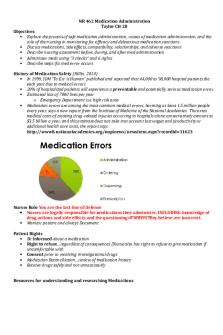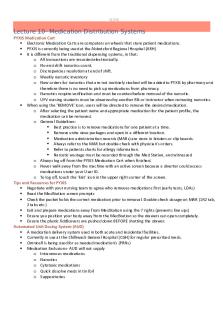Week 2- Medication Administration Safety PDF

| Title | Week 2- Medication Administration Safety |
|---|---|
| Course | Safe administration of medications |
| Institution | Griffith University |
| Pages | 7 |
| File Size | 553.2 KB |
| File Type | |
| Total Downloads | 15 |
| Total Views | 124 |
Summary
Lecture Notes 1807NRS Safe administration of medications...
Description
Week 2: Medication Administration Safety The Therapeutic Goods Administration TGA Evaluates, assesses and monitors the therapeutic goods in Australia Provides a national system of control relating to the quality, safety, efficacy and time availability of ytheratpuri good used in, or exported from Australia
Listed Medicines = AUST L - Registered Medicines = AUST R
Schedule 2 = Schedule 3 =
Schedule 4 = Schedule 5 = Schedule 6 =
Pharmacy medicine for therapeutic use, available without a prescription e.g paracetamol. Pharmacist only medicine must establish the pt’s therapeutic needs and provide instructions for use. E.g Paracetamol with Codeine. Prescription only medicine, needs to be endorsed and records kept for 2 years e.g Panadiene forte or valium. Low toxicity or domestic poison, agricultural or industrial and veterinary products e.g Borax High toxicity, ingestion can cause death. Also agricultural, industrial and veterinary. E.g Dieldrin
Schedule 7 = Schedule 8 = Schedule 9 =
High to extremely high toxicity. May cause death with even a minor exposure to the drug. E.g Cyanide Dependency producing drugs. Likely to be abused or misused. E.g Morphine Prohibited by law. E.g Heroin
QLD Regulations Health act 1937 (QLD) Health (Drug and poisons) Regulations 1996 (QLD) A RN is authorised to: Administer a controlled drug (schedule 8) to a patient on a doctor's oral or written instructions Administer a schedule 4 medication on medication or oral instruction Administer a schedule 2 or 3 poison May be administered after being checked by an RN & RN, an RN & EN or an RN & MO. Controlled Drugs (Schedule 8) Records of controlled drugs Records must be kept and the dolling information must be maintained when a controlled drug is administered: Description and quantity of drug Date and time of administration Name of the patient to whom it was administered Quantity of the controlled drug remaining Signature of the person who checked the drug prior to administration Signature of the person who administered drug Legal responsibilities of the RN are set out in the Health (Drugs & Poisons) Regulation 1996 (QLD) Roles & Responsibilities of the RN: 1. Patient Assessment 2. Patient Education 3. Patient Adherence to medication regime 4. Adhering to the Rights of Medication Administration 5. Patient Advocacy 6. Ongoing evaluation of the medication efficacy
Routes of Medication Administration
Nocte. = At night Mane = Morning Drug Storage Store away from sunlight, moisture of extreme temperatures Mandy drugs need to be stored between 0C to 40C Carefully check expiry dates Medication administration steps 1. The doctor reviews the patient 2. The doctor writes out the prescription 3. The pharmacist receives the prescription 4. The pharmacist dispenses the medication 5. Delivery of medication to the Ward 6. The nurse prepares the medications 7. The nurse Administers the medication 8. The nurse records the administration of medication in the patient’s chart
Medication Errors
Pain Assessment The nurse’s role in pain management Inadequate pain management may be due to: Insufficient knowledge and skills/Unwillingness to believe report of pain/Lack of time to assess/Inaccuracy or inadequate information/Fear Nurses are responsible for: Assessing pain, Initiation and coordination of pain relief, Evaluation of the effectiveness, Advocating for people with pain. Pain Scales
Pain scales are useful tools to help the patient communicate pain intensity. Scales must be adjusted for age and cognitive development. Pain charts provide both an assessment and documentation tool OLDCART
PQRST
ABBEY PAIN SCALE
Breakthrough pain: transient, moderate-to-severe pain that occurs beyond the pain treated by current analgesics. Including burning, numbing, shooting, stabbing or itchy sensation. Nociceptive pain: sharp, aching, throbbing, and cramping. Associated symptoms, such as anxiety, fatigue, and depression, may exacerbate or be exacerbated by the pain Pain Harmful effects of unrelieved pain: Endocrine/metabolic, Cardiovascular, Gastrointestinal, Neurological & Immunological Signs and symptoms of inflammation: Redness, heat, swelling and pain. Untreated pain can result in unnecessary suffering, physical and psychosocial dysfunction, impaired recovery from acute illness and surgery, immunosuppression, and sleep disturbances Types of pain /Pain is classified as: Nociceptive: Produced from the activation of peripheral nociceptors – noxious stimuli / chemically mediated Neuropathic: Caused by damage to peripheral nerves or the CNS Types of Pain: Somatic: Arising from skin, bone, joint, muscle or connective tissue. Presents as throbbing, Well localised. Visceral: Arising from internal organs such as large intestine or pancreas. Visceral nociceptors respond to inflammation, stretching & ischemia, Present as feeling of pain, Either referred or localised
Acute vs Chronic pain Acute Pain: Typically diminishes over time as healing occurs Chronic Pain: Lasts for longer periods > 3 months Or past the time when an expected acute pain or acute injury should subside
Nociceptors respond to ‘tissue damage’ or ‘potentially tissue damaging stimuli’ Nociception: Nocere = To injure Specialized sensory neurons known as nociceptors alert us to potentially damaging stimuli at: Skin (peripheral nociception) Bone Muscle Joint viscera blood vessels Involves transduction, transmission Perception and modulation...
Similar Free PDFs

Medication Administration
- 3 Pages

Medication Administration
- 6 Pages

Chapter 31 Medication Administration
- 18 Pages

Chapter 31 Medication Administration
- 27 Pages

Test 1 Medication Administration
- 9 Pages

Chapter 35 Medication Administration
- 16 Pages
Popular Institutions
- Tinajero National High School - Annex
- Politeknik Caltex Riau
- Yokohama City University
- SGT University
- University of Al-Qadisiyah
- Divine Word College of Vigan
- Techniek College Rotterdam
- Universidade de Santiago
- Universiti Teknologi MARA Cawangan Johor Kampus Pasir Gudang
- Poltekkes Kemenkes Yogyakarta
- Baguio City National High School
- Colegio san marcos
- preparatoria uno
- Centro de Bachillerato Tecnológico Industrial y de Servicios No. 107
- Dalian Maritime University
- Quang Trung Secondary School
- Colegio Tecnológico en Informática
- Corporación Regional de Educación Superior
- Grupo CEDVA
- Dar Al Uloom University
- Centro de Estudios Preuniversitarios de la Universidad Nacional de Ingeniería
- 上智大学
- Aakash International School, Nuna Majara
- San Felipe Neri Catholic School
- Kang Chiao International School - New Taipei City
- Misamis Occidental National High School
- Institución Educativa Escuela Normal Juan Ladrilleros
- Kolehiyo ng Pantukan
- Batanes State College
- Instituto Continental
- Sekolah Menengah Kejuruan Kesehatan Kaltara (Tarakan)
- Colegio de La Inmaculada Concepcion - Cebu









